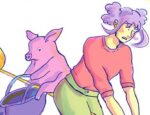In the debut issue of The Life After, Joshua Hale Fialkov and Gabo demonstrate their depth of skill and imagination, crafting a world that blends and balances lofty philosophical questions with the monotony of life – a dichotomy that extends to the book’s tone, which sits somewhere between the classic and the contemporary.
One of the fundamentals of the human condition is the question of our place and purpose in the universe. More specifically, the question has become: is there anything to our lives beyond the material? When the brain impulses stop firing and the elements of our body disseminate back into the surrounding environment, is there anything of us that remains? Is there such a thing as a soul?
The Life After, as the title suggests, is very blunt in its position on this question; the soul is unquestionably something that exists, and when we die that soul passes to another plane of existence.
What differentiates The Life After is its conception of the afterlife as a hazy dream: a mind-numbing monotony that distracts rather than clarifies.
But the restless sleeps, constant traffic, and menial bureaucratic labour come crumbling down when the book’s protagonist, Jude, acts on impulse for once and attempts to return a handkerchief to a woman on the bus. Every day she dropped it and every day he let her go, but on the day he chooses a different path, Jude catches visions of past, present and future, realizing that he, the woman, and everyone else are all dead souls occupying the purgatory for suicides.
 The story, written by Joshua Hale Fialkov, draws its strength from the mystery of the world it occupies.
The story, written by Joshua Hale Fialkov, draws its strength from the mystery of the world it occupies.
Death and the afterlife are the ultimate mystery, and by blending that existing intrigue with the dystopian conspiracy set-up of the plot, Fialkov has created a unique breed of suspense that is both ancient and primal but also deeply modern.
Jude’s narration is incredibly poetic, and the interplay of the captions is extremely well thought out; on the other hand, there is a quirkiness to the characters and the dialogue. The two don’t necessarily line up, but it all feeds into the conflicting forces that power the book. Whether intellectual or light-hearted, Fialkov taps into both our quotidian and our existential anxieties – a terrifically smart device that makes the story feel both timeless and timely.
Gabo’s unique artwork manages this balance quite well. The panel layouts are simple and elegant, and the colours are soft, reinforcing the timeless quality of the afterlife. This feels like a story that has been told in every age, with the art evoking a classic, almost Dickensian bleakness, even when it isn’t literally set in the 19th century.
By contrast, the sharp lines feel incredibly modern, and Gabo utilizes this to give incredible detail to the facial expressions in the book. From the anguish and dread written on Jude’s face to the sublime peace on the face of the woman as she ascends through the ceiling, the thoughts and emotions of the characters are clear and palpable.
Gabo’s visual effects are equally modern in feel, though he manages to skirt the line between the supernatural and the hyper-modern as the entire world crumbles, fades, blips, glows, floats, and dissolves in and out of existence.
Throughout The Life After, Fialkov and Gabo dance effortlessly between such different visions of the afterlife. Moreover, they also show tremendous dexterity in grounding the suspense, conspiracy, and dystopian elements with the more poetic and literary aspects of the story. The balancing act they perform evokes the liminal nature of Purgatory: existing between absolutes, neither one thing nor the other.
In many ways, this ends up feeling like Mike Mignola’s recent work on Hellboy in Hell; each textual and visual element invites the reader to contribute their own interpretation and to read between the lines. It’s visceral, as if the act of reading the book is in itself an exploration of your own perception of life and afterlife.
There is far more to this book than the words and images we are given. Somewhere in between the art and the writing is an philosophical experience – a dread curiosity and a critical desire to have a meaning beyond our material existence.
The Life After is a wonderfully sophisticated piece of graphic literature that can both delight and intrigue while asking us to earnestly look inward.
Joshua Hale Fialkov (W), Gabo (A) • Oni Press. $3.99. July 9, 2014.
















